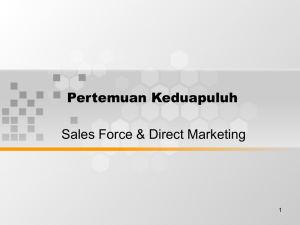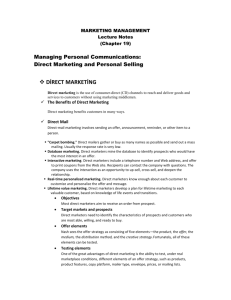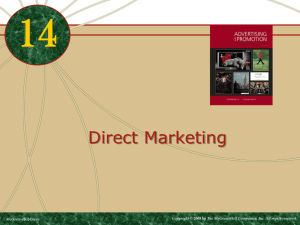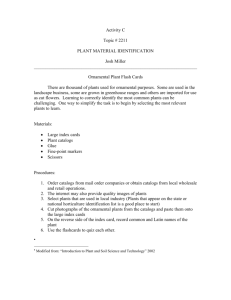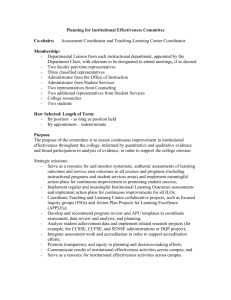MANAGING PERSONAL COMMUNICATIONS : Direct Marketing
advertisement
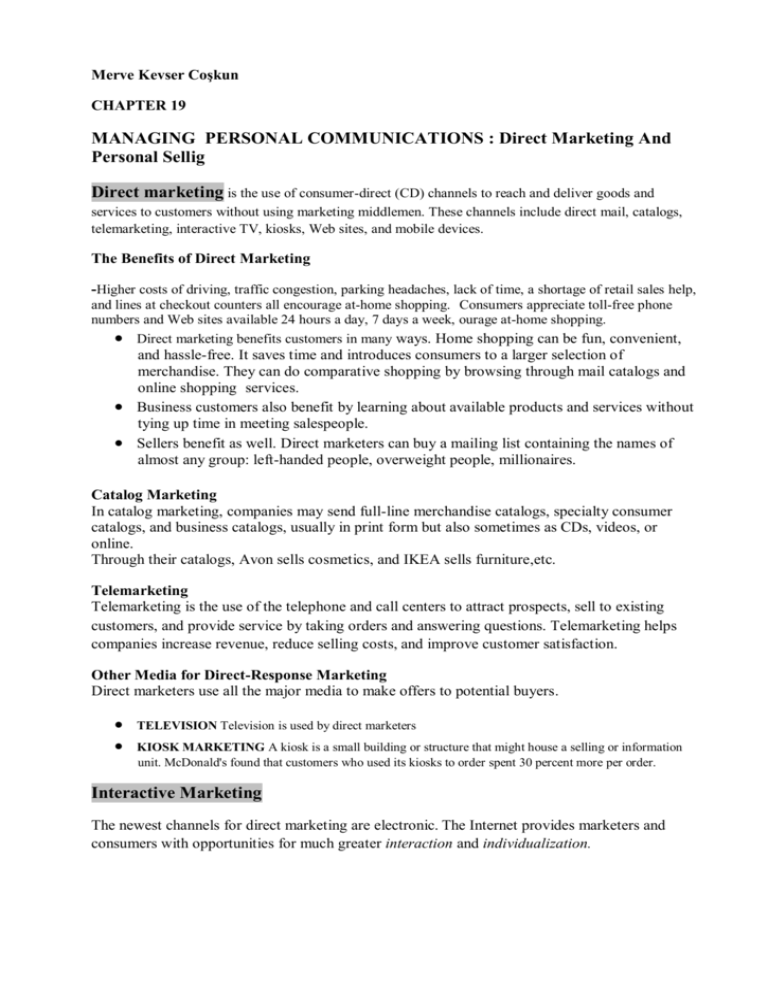
Merve Kevser Coşkun CHAPTER 19 MANAGING PERSONAL COMMUNICATIONS : Direct Marketing And Personal Sellig Direct marketing is the use of consumer-direct (CD) channels to reach and deliver goods and services to customers without using marketing middlemen. These channels include direct mail, catalogs, telemarketing, interactive TV, kiosks, Web sites, and mobile devices. The Benefits of Direct Marketing -Higher costs of driving, traffic congestion, parking headaches, lack of time, a shortage of retail sales help, and lines at checkout counters all encourage at-home shopping. Consumers appreciate toll-free phone numbers and Web sites available 24 hours a day, 7 days a week, ourage at-home shopping. Direct marketing benefits customers in many ways. Home shopping can be fun, convenient, and hassle-free. It saves time and introduces consumers to a larger selection of merchandise. They can do comparative shopping by browsing through mail catalogs and online shopping services. Business customers also benefit by learning about available products and services without tying up time in meeting salespeople. Sellers benefit as well. Direct marketers can buy a mailing list containing the names of almost any group: left-handed people, overweight people, millionaires. Catalog Marketing In catalog marketing, companies may send full-line merchandise catalogs, specialty consumer catalogs, and business catalogs, usually in print form but also sometimes as CDs, videos, or online. Through their catalogs, Avon sells cosmetics, and IKEA sells furniture,etc. Telemarketing Telemarketing is the use of the telephone and call centers to attract prospects, sell to existing customers, and provide service by taking orders and answering questions. Telemarketing helps companies increase revenue, reduce selling costs, and improve customer satisfaction. Other Media for Direct-Response Marketing Direct marketers use all the major media to make offers to potential buyers. TELEVISION Television is used by direct marketers KIOSK MARKETING A kiosk is a small building or structure that might house a selling or information unit. McDonald's found that customers who used its kiosks to order spent 30 percent more per order. Interactive Marketing The newest channels for direct marketing are electronic. The Internet provides marketers and consumers with opportunities for much greater interaction and individualization. The Benefits of Interactive Marketing It is highly accountable and its effects can be easily traced The Web offers the advantage of "contextual placements." Marketers can buy ads from sites that are related to their offerings, as well as place advertising based on contextual keywords from online search outfits like Google. In that way, the Web can reach people when they have actually started the buying process. Light consumers of other media, especially television, can be reached. The Web is especially effective at reaching people during the day. Young, high-income, high-education customers'. E-Marketing Guidelines If a company does an e-mail campaign right, it can not only build customer relationships, but also reap additional profits. E-mail involves only a fraction of the cost of a "d-mail," or direct-mail, campaign. For example, Microsoft spent approximately $70 million a year on paper-driven campaigns. Some Important Guidelines o o Give the customer a reason to respond. Personalize the content of your e-mails. IBM's iSource is distributed directly to customers' office e-mail each week. o Offer something the customer could not get via direct mail. o Make it easy for customers to "unsubscribe". Designing the Sales Force Designing the Sales Force Sales force objectives ss Sales force strategy Sales force structure Sales force size Sales force compensation Sales Force Objectives and Strategy Companies need to define the specific objectives they want their sales force to achieve. For example, a company might want its sales representatisves to spend 80 percent of their time with current customers and 20 percent with prospects. Sales Force Structure The sales force strategy has implications for the sales force structure. A company that sells one product line to one end-using industry with customers in many locations. Motorola, for example, manages four types of sales forces: (1) a strategic market sales force composed of technical, applications, and quality engineers and service personnel assigned to major accounts; (2) a geographic sales force calling on thousands of customers in different territories; (3) a distributor sales force calling on and coaching Motorola distributors; and (4) an inside sales force doing telemarketing and taking orders via phone and fax. Sales Force Size The company clarifies its strategy and structure, it is ready to consider sales force size. Sales Force Compensation To attract top-quality sales reps, the company has to develop an attractive compensation package. The company must determine the four components of sales force compensation—a fixed amount, a variable amount, expense allowances, and benefits. Managing the Sales Force Once the company has established objectives, strategy, structure, size, and compensation, it has to recruit, select, train, supervise, motivate, and evaluate sales representatives. Various policies and procedures guide these decisions. Managing the Sales Force Recruiting and selecting sales representa tives Training sales represent atives Supervisi ng sales represen tatives Motivatin g sales represent atives Evaluating sales representat ives Recruiting and Selecting Representatives At the heart of a successful sales force is the selection of effective representatives. Training and Supervising Sales Representatives Today's customers expect salespeople to have deep product knowledge, to add ideas to improve the customer's operations, and to be efficient and reliable. These demands have required companies to make a much higher investment in sales training. Motivating Sales Representatives The majority of sales representatives require encouragement and special incentives.Most marketers believe that the higher the salesperson's motivation, the greater the effort and the resulting performance, rewards, and satisfaction—and thus further motivation. Evaluating Sales Representatives An active order getter learns how to listen and question in order to identify customer needs and come up with sound product solutions. The Six Steps PROSPECTING and QUALIFYING The first step in selling is to identify and qualify prospects. PREAPPROACH The salesperson needs to learn as much as possible about the prospect company PRESANTATION AND DEMONSTRATION The salesperson now tells the product "story" to the buyer. OVERCOMING OBJECTIONS Customers typically pose objections during the presentation or when asked for the order. CLOSING Now the salesperson attempts to close the sale. Salespeople need to know how to recognize closing signs from the buyer, including physical actions, statements or comments, and questions. FOLLOW-UP AND MAINTENANCE Follow-up and maintenance are necessary if the salesperson wants to ensure customer satisfaction and repeat business.
